Repeating the same retrospective format Sprint after Sprint drains engagement and reduces the value of your team meetings. After facilitating hundreds of agile retrospectives, I’ve identified how format variety surfaces different insights, keeps teams engaged, and prevents retrospectives from becoming checkbox exercises.
These 20 retrospective techniques follow the five-phase process that makes retrospectives effective: set the stage, gather data, analyze insights, decide what to do, and take action. If you’re new to facilitating retrospectives, start with the foundational framework before exploring these formats.
Each retrospective format provides a different perspective for examining your Sprint. Some work better for specific team situations, emotional states, or sprint outcomes. Select the format based on your team’s current needs rather than defaulting to what worked previously.
How to Use This Guide
The 20 retrospective formats below are organized by use case to help you quickly find the right technique for your situation. New to retrospectives? Start with “Getting Started.” Dealing with team morale issues? Jump to “Building Team Health & Morale.” Each category serves a specific purpose in your facilitation toolkit.
Quick Navigation by Category
Getting Started: Simple Retrospective Formats for New Teams
Retrospective Formats for Building Team Health & Morale
Visual & Creative Retrospective Approaches
Retrospectives for Detailed Analysis & Feedback
Retrospectives for Technical & Quality Focus
Retrospectives for Strategic & Future Planning
Meta: Improving Retrospectives Themselves
Getting Started: Simple Retrospective Formats for New Teams
These formats work well for teams new to retrospectives or when you’re short on time. They’re straightforward, require minimal setup, and create immediate value.
1. Pluses and Deltas

Best for: Teams new to retrospectives, time-constrained sessions, when you need simplicity
How it works:
Create two columns: “Pluses” (what went well) and “Deltas” (what we want to change). The term “delta” frames issues as opportunities for improvement rather than failures.
Gather Data: Team members add observations to both columns using sticky notes or digital collaboration tools.
Analyze: Group similar items and identify patterns. Examine whether deltas relate to process, people, tools, or external factors.
Discuss and Act: Vote on the top 2-3 deltas to address and create specific action items with owners and deadlines.
Why it works: The simplicity removes barriers to participation. Framing negatives as “deltas” maintains a constructive, forward-looking tone that encourages honest feedback.
Pro tip: An empty pluses column with an overflowing deltas column signals potential team morale issues. Consider switching to an emotionally-focused format like Mad-Sad-Glad for your next retrospective.
2. Start-Stop-Continue

Best for: Action-oriented teams, when you need clear behavioral changes, teams stuck in patterns
How it works:
Create three columns:
- Start: What should we begin doing?
- Stop: What should we cease doing?
- Continue: What’s working that we should keep doing?
Gather Data: Team members populate all three columns with specific behaviors, practices, or approaches rather than vague observations.
Analyze: Look for conflicts where one person wants to start what another wants to stop. Identify items that appear in multiple categories.
Discuss and Act: Prioritize items in each category. Address the “stop” column honestly, as teams often find this most challenging but most valuable.
Why it works: This format forces teams to think about specific behaviors and practices rather than abstract problems. The “continue” column reinforces successful practices instead of only focusing on fixes.
Pro tip: The “stop” column is often hardest to fill. If it’s empty, prompt with questions like “What takes time but adds little value?” or “What would we not miss if it disappeared tomorrow?” For deeper discussions about what to continue or stop, consider using structured facilitation techniques to ensure everyone contributes.
3. One Word

Best for: Quick check-ins, starting or ending other formats, getting to the essence, when time is limited
How it works:
Each team member chooses one word that captures their Sprint experience.
Gather Data: Go around the room or use a digital tool for each person to share their one word. Write them all down visibly.
Analyze: After everyone shares, ask people to explain why they chose their word. Look for patterns in whether most words are positive or negative and whether they cluster around themes (stress, flow, chaos, success).
Discuss and Act: Dig deeper into surprising or concerning words. For example, “You said ‘exhausting.’ What made it exhausting? What would ‘energizing’ look like instead?”
Why it works: Constraints breed creativity. One word forces people to identify the essence of their experience. The format is quick and reveals surprising insights.
Pro tip: This also works as a check-in at the start of a longer retrospective using a different format. It sets the emotional tone effectively.
Building Team Health & Morale
Use these formats when team morale is low, after difficult sprints, or when you need to address emotional challenges and rebuild psychological safety.
4. Mad-Sad-Glad

Best for: Teams experiencing emotional challenges, after difficult sprints, when morale needs attention
How it works:
Three emotion-based categories:
- Mad: What frustrated or angered you?
- Sad: What disappointed you or made you feel down?
- Glad: What made you happy or proud?
Gather Data: Team members share experiences through an emotional lens. Encourage specificity: instead of “I was mad about the deployment,” try “I was mad that we discovered the staging environment was broken only during deployment.”
Analyze: Notice emotional patterns across the team. Are specific issues generating strong emotions? Do individual experiences differ significantly?
Discuss and Act: Address items generating the strongest emotions first, as these often indicate deeper systemic issues.
Why it works: This format legitimizes emotions in professional settings and surfaces issues that clinical formats miss. Emotions provide valuable data about team health and Sprint challenges.
Pro tip: This format requires strong psychological safety. If your team isn’t ready for emotional vulnerability, build up to it with simpler formats first.
5. Oscar Ceremony

Best for: Building team morale, after successful sprints, celebrating achievements, teams needing appreciation
How it works:
Create award categories for the Sprint:
- Best Supporting Team Member
- Best Problem Solver
- Best Comeback Story
- Most Valuable Player
- Best Technical Innovation
- Funniest Moment
- Best Collaboration
- Biggest Learning Moment
Gather Data: Team members nominate and vote for winners in each category. Nominees can include individuals, pairs, or the whole team.
Analyze: While celebrating, notice what behaviors and achievements the team values. These reveal your team’s actual values rather than stated ones.
Discuss and Act: Use the ceremony itself as the primary value, but also create action items around creating more moments worth celebrating.
Why it works: This format builds morale and psychological safety through appreciation. The approach is memorable and reinforces positive behaviors through recognition.
Pro tip: Rotate who creates award categories or let the team vote on categories at the beginning of the retrospective.
6. Team Radar
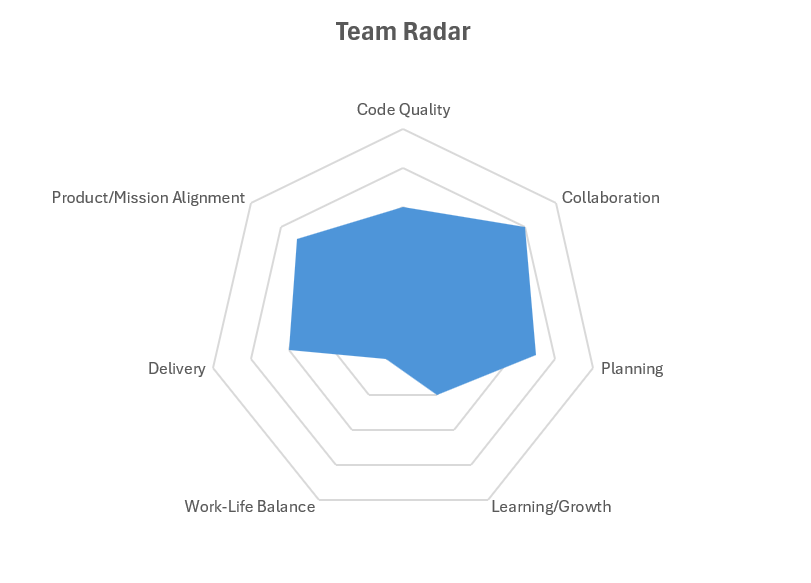
Best for: Measuring team health, tracking trends over time, identifying specific pain points, leadership reviews
How it works:
Create a radar chart with multiple dimensions:
- Code Quality
- Collaboration
- Planning
- Learning/Growth
- Work-Life Balance
- Delivery
- Product/Mission Alignment
Gather Data: Each team member privately rates satisfaction with each dimension (1-5 or 1-10). Calculate averages or show individual ratings anonymously.
Analyze: Look for dimensions with low scores or high variance. Compare to previous sprints if tracking over time.
Discuss and Act: Focus discussion on the 1-2 lowest-scoring dimensions. Understand what would improve those scores.
Why it works: This format provides quantitative data about team sentiment across multiple areas. The approach focuses on overall team health rather than individual Sprint outcomes.
Pro tip: Track this over time (quarterly) to identify trends. A single snapshot is interesting; a trend is actionable.
7. Circles and Soup

Best for: Teams feeling powerless, managing expectations, focusing energy appropriately, dealing with organizational change
How it works:
Draw three concentric circles:
- Inner Circle (Control): What we can directly control and change
- Middle Circle (Influence): What we can affect but don’t fully control
- Outer Circle (Soup): External factors we can’t control or influence
Gather Data: Team members place their observations and concerns into the appropriate circle.
Analyze: Notice where most items fall. If everything lands in “Soup,” the team may feel helpless and might need coaching on what they can actually influence. If everything is in “Control,” they might be taking excessive responsibility.
Discuss and Act: Focus discussion and action items on the Control circle. For Influence items, discuss how to expand influence. For Soup items, discuss how to adapt or mitigate impact.
Why it works: This format helps teams stop wasting energy on unchangeable factors and focus where they can make a difference. The approach is empowering and clarifying.
Pro tip: Revisit “Soup” items quarterly. Sometimes things move from Soup to Influence as context changes or the team gains seniority.
Visual & Creative Approaches
These formats engage different cognitive processes through visual metaphors and creative expression. Perfect for visual thinkers, breaking through routine, or when traditional discussion methods aren’t working.
8. Sailboat
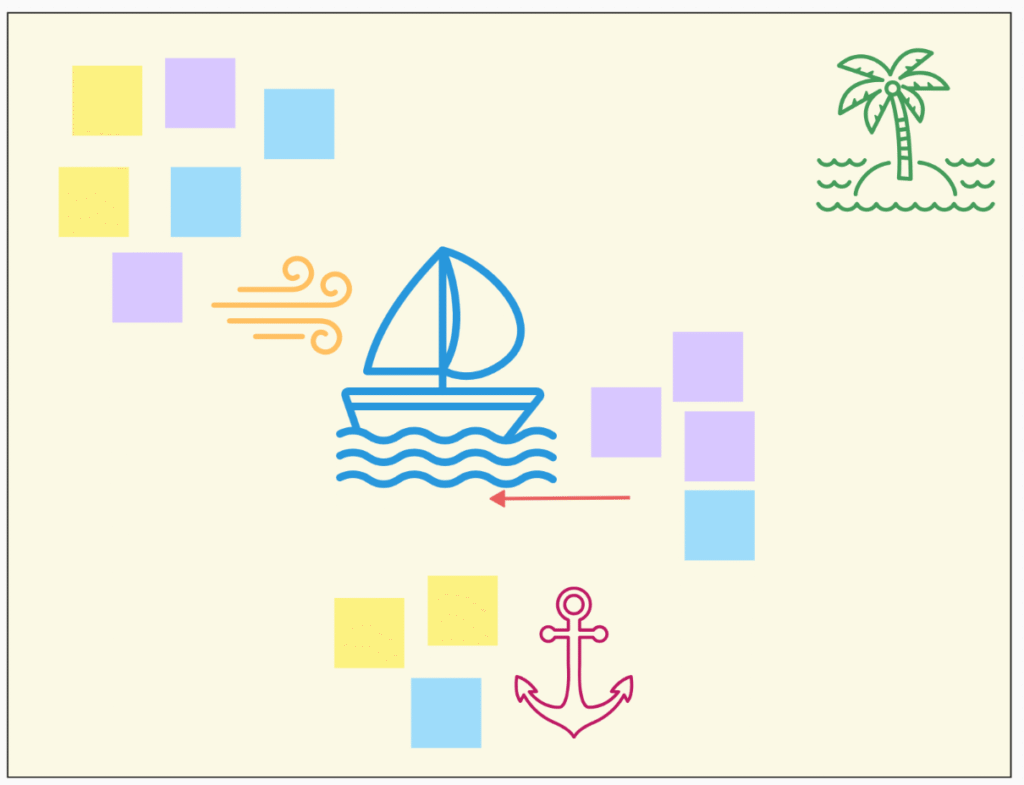
Best for: Visual thinkers, teams facing obstacles, when you want to make abstract concepts concrete
How it works:
Draw a sailboat on water heading toward an island:
- Island: Your goal (Sprint Goal, release, or vision)
- Wind: What propels you forward
- Anchors: What holds you back or slows you down
- Rocks or Current: Risks or obstacles ahead
- Sun/Weather: External conditions affecting the journey (optional)
Gather Data: Team members add items to each metaphor element.
Analyze: Examine the balance between wind and anchors. Determine whether you’re facing more forces pushing forward or holding back. Assess whether identified risks are truly ahead or already impacting progress.
Discuss and Act: Focus first on removing anchors (quick wins), then on avoiding rocks (risk mitigation), then on increasing wind (amplifying what works).
Why it works: Visual metaphors transform abstract concepts into concrete images. The nautical journey theme provides an intuitive framework everyone understands.
Pro tip: Physically draw the sailboat on a whiteboard or use a digital template. The visual component makes this format powerful and memorable.
9. Speed Car
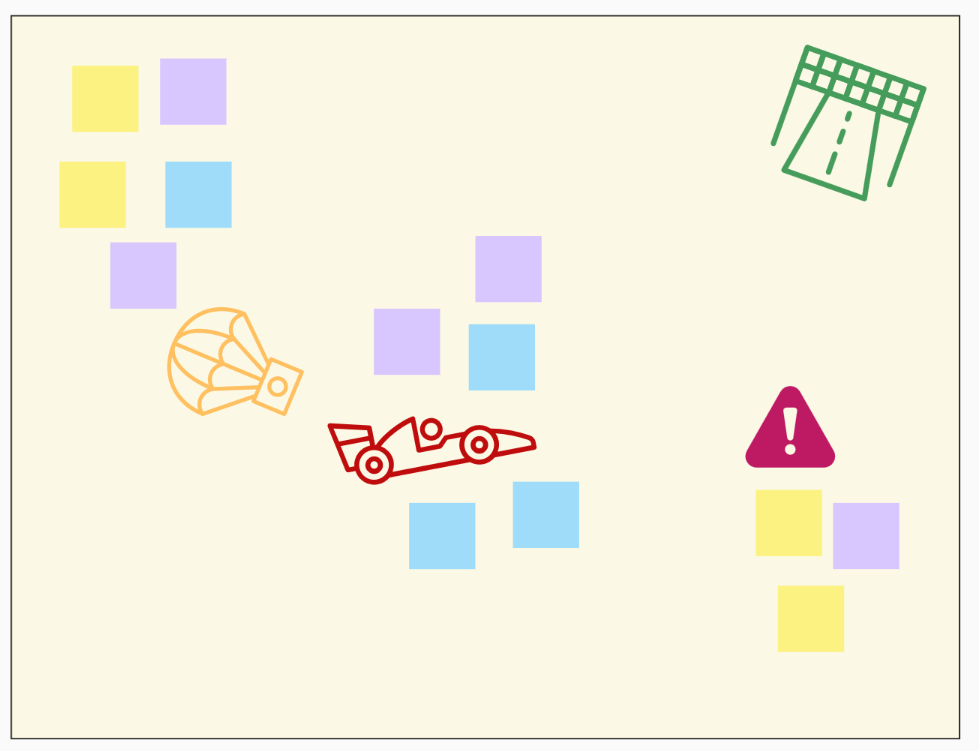
Best for: Fast-paced teams, when energy is low, focusing on acceleration and blockers
How it works:
The Sprint is a race car heading toward a finish line:
- Engine: What drives us forward?
- Parachutes: What slows us down?
- Finish Line: Where are we trying to go?
- Cliff/Hazards: What dangers lie ahead? (optional)
Gather Data: Team members identify elements in each category.
Analyze: Consider the ratio of engine to parachutes. Determine whether you’re being slowed more than propelled forward. Assess whether parachutes are necessary (safety mechanisms) or unnecessary (bureaucracy).
Discuss and Act: Remove unnecessary parachutes, strengthen the engine, and plan routes around hazards.
Why it works: The racing metaphor appeals to competitive teams and naturally focuses discussion on speed and effectiveness.
Pro tip: This format works especially well for teams focused on cycle time and throughput metrics.
10. Draw Me a Picture
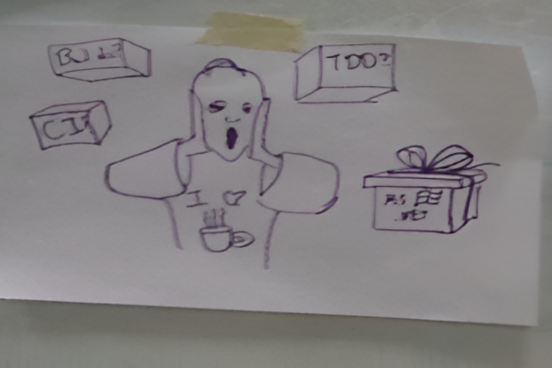
Best for: Creative teams, when verbal expression isn’t working, breaking through routine, remote teams needing engagement
How it works:
Instead of writing, team members draw pictures representing their Sprint experience.
Gather Data: Each person creates a drawing (stick figures work perfectly) representing how the Sprint felt or what happened. Provide 5-7 minutes of quiet drawing time.
Analyze: Each person shares their drawing and explains it. Others ask questions. Look for common themes across drawings.
Discuss and Act: Identify stories or themes that emerged from multiple drawings and create action items based on those patterns.
Why it works: This format engages different cognitive processes and often surfaces feelings and experiences that wouldn’t emerge through words. The approach also reduces tension and adds enjoyment.
Pro tip: Emphasize that artistic skill doesn’t matter. Simple shapes and stick figures are perfect. Focus on meaning rather than artistic quality.
11. Timeline
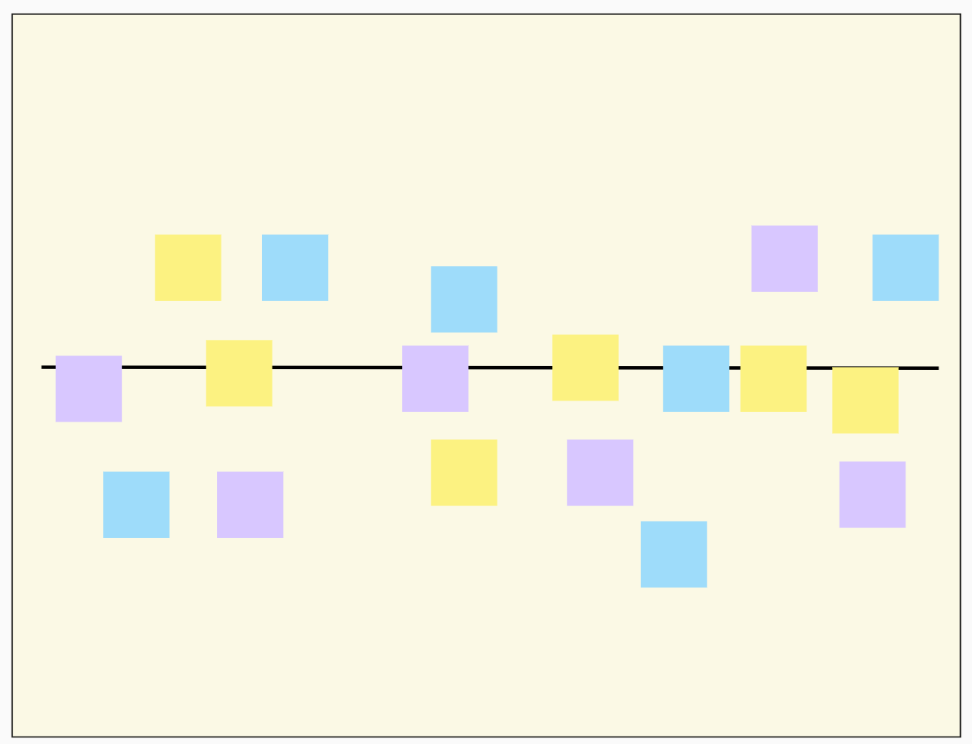
Best for: 1 month Sprints, after a major release, when significant events occurred, distributed teams catching up
How it works:
Create a horizontal timeline representing the period from start to finish.
Gather Data: Team members add events, decisions, and milestones to the timeline. Use different colors for event types (technical, team, external) and different placement for emotional valence (positive above the line, negative below the line, neutral on the line).
Analyze: Look for clustering patterns. Are problems concentrated at certain times? Notice the emotional journey throughout the Sprint. Identify correlations between events.
Discuss and Act: Focus on patterns and inflection points. Determine what caused shifts and how to prevent negative patterns while creating more positive ones.
Why it works: This format creates a shared narrative and reveals cause-and-effect relationships that aren’t obvious when examining isolated incidents.
Pro tip: Add significant external events (holidays, company announcements, production issues) to provide context. This helps teams recognize that not everything falls within their control.
Detailed Analysis & Feedback
These formats provide nuanced, comprehensive examination of Sprint performance. Best for mature teams ready for detailed analysis and those wanting deeper insights.
12. Starfish

Best for: Teams needing nuanced feedback, when “start/stop” feels too binary, mature teams ready for detailed analysis
How it works:
Five categories radiating from center like a starfish:
- Keep Doing: What’s working well?
- Less Of: What should we reduce but not eliminate?
- More Of: What should we increase or emphasize?
- Stop Doing: What should we completely cease?
- Start Doing: What new practices should we begin?
Gather Data: Team members contribute to all five categories.
Analyze: Notice the nuance in responses. “Less Of” and “More Of” often reveal practices that need balance and proportion rather than elimination or adoption.
Discuss and Act: Prioritize across all categories. You don’t need action items in every category for each retrospective.
Why it works: The five categories provide more nuance than three-column formats. The approach acknowledges that effectiveness often involves more or less of something rather than all or nothing.
Pro tip: The “More Of” category often contains quick wins. These are practices already working that just need amplification.
13. 4Ls: Liked, Learned, Lacked, Longed For
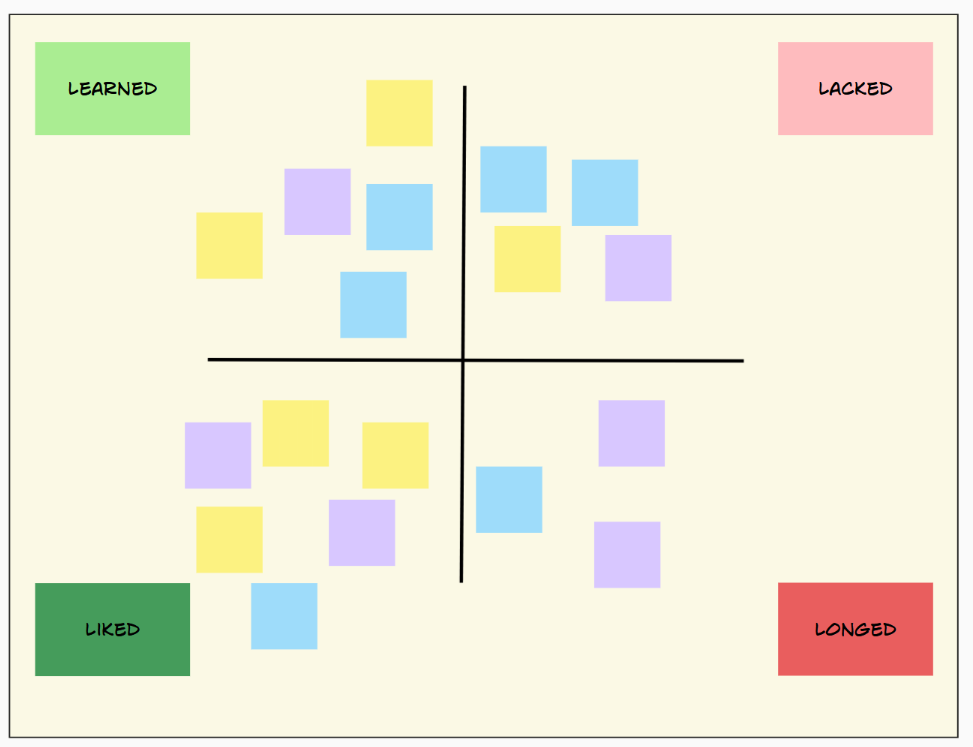
Best for: Comprehensive retrospectives, learning-focused teams, quarterly or release retrospectives
How it works:
Four categories that provide complete perspective:
- Liked: What did we enjoy or appreciate?
- Learned: What new knowledge, skills, or insights did we gain?
- Lacked: What was missing or insufficient?
- Longed For: What did we wish we had?
Gather Data: Team members contribute to all four categories. An empty “Learned” column indicates the team isn’t growing from the Sprint experience.
Analyze: Compare “Lacked” and “Longed For” categories, which often reveal the same issues from different angles. Notice whether learnings came from successes or failures.
Discuss and Act: Prioritize items from “Lacked” and “Longed For” while celebrating items in “Liked” and “Learned.”
Why it works: This format balances positive and negative feedback while explicitly focusing on learning and growth. The alliteration makes it memorable for teams.
Pro tip: The “Learned” category builds organizational knowledge. Document these learnings in a team wiki or knowledge base for future reference.
14. Perfection Game

Best for: Constructive feedback culture, improving specific processes, focusing on solutions not problems
How it works:
For each aspect of the Sprint (meetings, technical practices, collaboration):
- Rate it from 1-10
- Explain what you liked about it (what justifies the score you gave)
- Describe what would make it a perfect 10
Gather Data: Each person scores multiple aspects and provides their reasoning.
Analyze: Look at average scores and variance. A low score with high agreement suggests a clear problem. A low score with low agreement suggests different expectations or experiences.
Discuss and Act: Focus on items with low scores. Use the “what would make it a 10” responses to create action items. When the team struggles to reach consensus on which items to prioritize, apply decision-making techniques like dot voting or fist of five to move forward efficiently.
Why it works: This format is radically constructive. Even criticism starts with acknowledgment of what’s good. The “what would make it a 10” requirement forces solution-oriented thinking.
Pro tip: Don’t worry about achieving 10s in everything. Sometimes an honest 7 is sustainable and excellent.
Technical & Quality Focus
These formats work particularly well for engineering teams dealing with technical debt, code quality, and architecture decisions.
15. Three Little Pigs

Best for: Technical teams, discussing technical debt, quality conversations, architecture decisions
How it works:
Analyze your work through the lens of the fairy tale:
- Straw House: Fragile, temporary, will blow down easily (quick hacks, workarounds)
- Stick House: Okay, somewhat durable but could be better (acceptable solutions, minor tech debt)
- Brick House: Solid, sustainable, built to last (well-engineered, maintainable solutions)
- Big Bad Wolf: What threatens to blow it all down? (deadlines, changing requirements, technical complexity)
Gather Data: Team members categorize work, code, processes, or decisions into these categories.
Analyze: What percentage of your work falls into each category? Is your ratio healthy? What factors (the wolf) are forcing you to build with straw?
Discuss and Act: Create plans to shore up straw houses or rebuild them properly. Discuss how to protect against the wolf. Celebrate brick houses.
Why it works: The fairy tale metaphor makes technical debt discussions accessible to everyone. The approach is memorable and slightly humorous, which softens difficult conversations.
Pro tip: Sometimes straw houses are appropriate. A quick prototype or experiment doesn’t need brick construction. The key is being intentional about the choice.
16. Definition of Done (DoD) Review
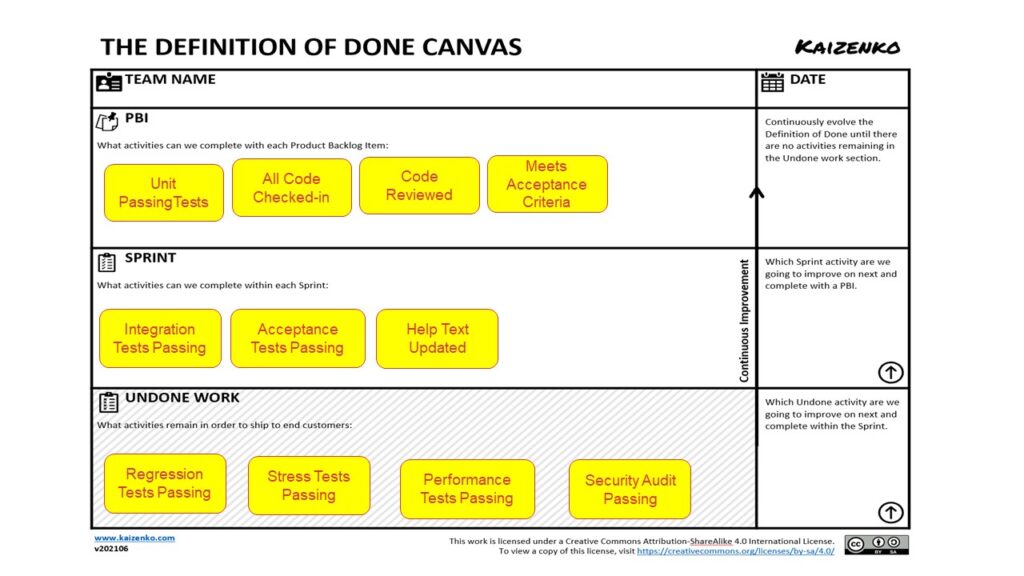
Best for: Quality-focused teams, when defects are increasing, process maturity improvement, preparing for compliance
How it works:
Review your team’s Definition of Done and evaluate how well you’re meeting it.
Gather Data:
- List your current DoD criteria
- Rate how consistently you meet each criterion (always/usually/sometimes/rarely)
- Identify which criteria are unclear or unrealistic
- Discuss what’s missing from your DoD
Analyze: Look for patterns. Are certain criteria regularly skipped? Why? Are there quality issues that aren’t addressed in your current DoD?
Discuss and Act:
- Remove criteria that don’t add value
- Clarify ambiguous criteria
- Add criteria that would improve quality
- Create action items to help the team meet criteria they’re currently missing
Why it works: The Definition of Done is your quality contract. Regularly reviewing and improving it ensures the DoD stays relevant and achievable. The approach makes quality discussions concrete rather than abstract.
Pro tip: Use the Definition of Done Canvas to help you strengthen it over time. Don’t make your DoD so strict that it becomes ignored. Better to have fewer criteria that are always met than many that are regularly skipped.
Strategic & Future Planning
These forward-looking formats help teams anticipate problems, plan for success, and conduct root cause analysis.
17. Futurespective

Best for: Sprint planning, beginning of product development, anticipating problems, risk management
How it works:
Instead of looking back, look forward. Imagine you’re at the end of the next Sprint or release.
Gather Data: First scenario: “Three weeks from now, the Sprint was amazing. What happened? What did we do differently?”
Second scenario: “The Sprint was a disaster. What went wrong? What mistakes did we make?”
Analyze: Look at conditions that led to success and failure in your imagined futures. Determine which are most likely and which would be most impactful.
Discuss and Act: Create action items to make the success scenario more likely and prevent the failure scenario.
Why it works: Imagining future problems is easier than admitting past mistakes. The format encourages proactive rather than reactive improvement.
Pro tip: This format is excellent at the start of high-risk or high-stakes sprints, or when starting work on a new product or feature.
18. Pre-mortem/Post-mortem Hybrid
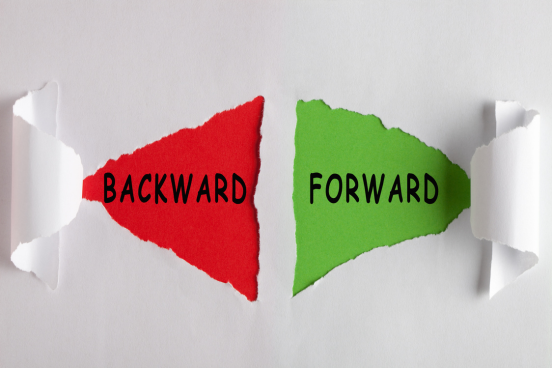
Best for: After significant failures, before risky initiatives, root cause analysis, preventing repeated mistakes
How it works:
Part 1 (Post-mortem): Reflect on what went wrong during the Sprint or a specific incident. Use the “Five Whys” or similar root cause analysis.
Part 2 (Pre-mortem): Now imagine the next Sprint has failed spectacularly. Fast-forward to the end and work backward: “What led to this failure? What warning signs did we ignore?”
Gather Data: In post-mortem, capture facts about what happened. In pre-mortem, capture imagined failure scenarios.
Analyze: Compare actual failures to imagined ones. Often, the same weaknesses appear in both.
Discuss and Act: Create action items that address both past failures and prevent imagined future ones.
Why it works: Combining backward and forward looking creates comprehensive risk awareness. The pre-mortem feels safer because it’s hypothetical.
Pro tip: This format can feel heavy. Use it when needed, not every Sprint. Balance with lighter, more positive formats.
Meta: Improving Retrospectives Themselves
These formats help you evaluate and improve your retrospective practice, creating continuity between sprints and ensuring retrospectives deliver value.
19. Return on Time Invested (ROTI)

Best for: Evaluating the retrospective itself, continuous improvement of retro facilitation, demonstrating value
How it works:
At the end of the retrospective, ask team members to rate the session:
- 0: Total waste of time
- 1: Didn’t get value equal to time spent
- 2: Got value equal to time spent
- 3: Got more value than time spent
- 4: Got much more value than time spent
Gather Data: Use fist-of-five, a quick poll, or anonymous voting.
Analyze: Calculate the average. Anything below 2 means your retrospectives aren’t delivering value. Ask what would have made it better.
Discuss and Act: Use low scores as feedback to improve your retrospective facilitation. Ask the team what would have made the session a 4.
Why it works: This format closes the feedback loop on retrospectives themselves. It demonstrates respect for the team’s time and helps you improve as a facilitator.
Pro tip: Conduct ROTI every retrospective. Track scores over time. If scores are consistently low, hold a meta-retrospective about your retrospectives.
20. Letter to Future Self

Best for: Creating continuity between sprints, accountability, capturing context and learning
How it works:
As a team, write a letter to yourselves to be read at the start of the next retrospective or next release.
Gather Data: Include:
- What we accomplished this Sprint
- Challenges we faced
- Commitments we’re making
- What we want to remember
- Questions we want to answer next time
Analyze: The act of writing the letter forces reflection and prioritization.
Discuss and Act: The action items are the commitments in the letter. At the next retrospective, open the letter and review how you did.
Why it works: This format creates a narrative thread across sprints. Reading your past self’s letter is surprisingly powerful for accountability.
Pro tip: Keep these letters in a shared location. Re-reading them quarterly or yearly provides perspective on team growth.
How to Choose the Right Retrospective Format

With 20 techniques organized into seven categories, selection becomes more straightforward. Start by identifying which category matches your current situation, then choose the specific format within that category.
By Team Maturity
- New teams: Start with “Getting Started” formats (Pluses & Deltas, Start-Stop-Continue, One Word)
- Mature teams: Explore “Detailed Analysis & Feedback” formats (Starfish, 4Ls, Perfection Game)
By Current Team State
- Low morale: Use “Building Team Health & Morale” formats (Mad-Sad-Glad, Oscar Ceremony, Happiness Radar)
- High morale: Try “Detailed Analysis & Feedback” or “Technical & Quality Focus” formats
- Feeling powerless: Choose Circles and Soup from “Building Team Health & Morale”
- Need fresh perspective: Explore “Visual & Creative Approaches” (Sailboat, Speed Car, Draw Me a Picture, Timeline)
By Sprint Characteristics
- Complex/eventful Sprint: Timeline from “Visual & Creative Approaches”
- Successful Sprint: Oscar Ceremony from “Building Team Health & Morale” or Futurespective from “Strategic & Future Planning”
- Failed Sprint: Pre-mortem/Post-mortem Hybrid from “Strategic & Future Planning” or Three Little Pigs from “Technical & Quality Focus”
- Technical focus: Use “Technical & Quality Focus” formats (Three Little Pigs, DoD Improvement)
By Time Available
- 45 minutes: One Word, Pluses & Deltas, ROTI
- 90 minutes: Most formats work well
- 90+ minutes: 4Ls, Timeline, comprehensive Starfish, Pre-mortem/Post-mortem Hybrid
By Frequency and Scope
- Regular Sprint Rotation: Pluses & Deltas, Start-Stop-Continue, One Word, Starfish, ROTI
- Quarterly Retrospectives: Happiness Radar, DoD Review, 4Ls, Oscar Ceremony
- After Major Releases: Timeline,, Futurespective, Pre-mortem/Post-mortem Hybrid
- Yearly Retrospectives: Oscar Ceremony, 4Ls, Letter to Future Self
Rotation Strategy
Build a balanced rotation that covers different categories:
- Regular rotation: Cycle through 4-5 formats from “Getting Started” and “Detailed Analysis & Feedback” categories
- Quarterly variety: Introduce formats from “Visual & Creative Approaches” once per quarter
- Situational use: Keep “Building Team Health & Morale,” “Technical & Quality Focus,” and “Strategic & Future Planning” formats ready for specific situations
- Every retrospective: Always close with ROTI from the “Meta” category to gauge effectiveness
Making Retrospectives Work
These 20 techniques are tools, not magic solutions. The format you choose matters less than your commitment to the five-phase retrospective process and to actually implementing the action items that emerge.
Building psychological safety in your team makes all retrospective formats more effective, as team members feel safe sharing honest feedback without fear of blame or repercussions.
The worst retrospective format is the one you use every single time. The second-worst is the one you use to check a box without taking action.
Try something new. Mix it up. Pay attention to what resonates with your team. Most importantly, close the loop by following through on your commitments.
The facilitation skills you develop running these retrospectives extend beyond your team meetings. If you’re looking to deepen your capabilities in team dynamics, psychological safety, and group decision-making, explore the Building High-Performing Teams Workshop for comprehensive leadership development.
Your team and your product will be better for it.
